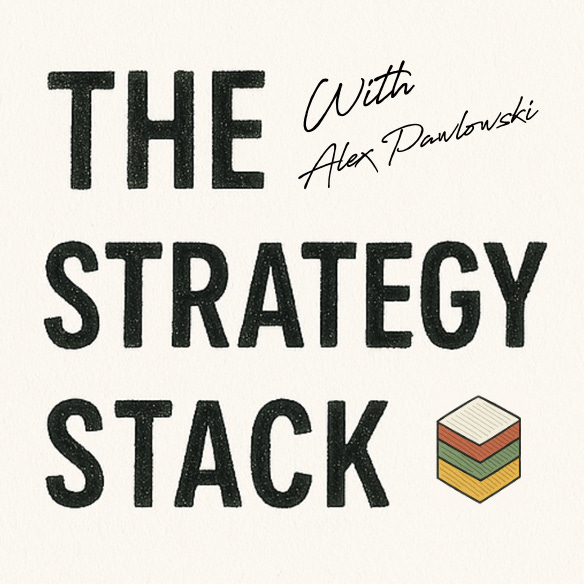👥 Featuring:
Host: Alex (The Strategy Stack)
Opening & Setup (Part 5 — Value Creation & Strategic Impact)
Alex opens Part 5 of the live series on the Agentic Operating Model (AOM). After a brief news round-up, he frames today’s goal: move beyond culture and architecture (Parts 1–4) to how agents create measurable value—from operations to market-shaping strategy.
Context: Friday live session; Part 5 follows Parts 1–4 and precedes Part 6 (multi‑agent ecosystems).
News Pulse (very brief)
OpenAI ↔ Microsoft governance shift and multicloud leverage (Oracle entry) → signals capital flows into compute and infrastructure, not just apps.
Microsoft in-house AI chips → vertical control of the stack.
EU’s first exascale (JUPITER) → sovereignty in compute.
UK–US tech pact → cross-Atlantic alignment on AI/quantum.
Samsung expanding Galaxy AI → edge/on‑device AI adoption.
Regulatory note: Microsoft unbundles Teams in EU → platform power under scrutiny.
Meta’s Ray‑Ban display glasses → wearables + AI shifting from prototype to product; privacy and reliability will be decisive.
(These headlines set the macro backdrop for value creation with agents.)
Why Value Creation Is Different With Agents
Agents aren’t chatbots. They introduce cognitive leverage—amplifying judgment, adaptability, and innovation at scale. Value shifts from pure efficiency (digital era) to faster, better decisions and new strategic options.
Four Levels of Agentic Value
Operational Efficiency
Automate repetitive workflows (invoice processing, L1 support).
Track: cost per transaction, cycle time, error rates.Decision Acceleration
Collapse decision latency (days → minutes).
Track: signal‑to‑action time, % decisions automated, escalation rate.Strategic Adaptability
Sense market shifts and reallocate resources in near‑real time.
Track: pivot speed, new revenue streams, retention.Market Redefinition
New products/services/business models enabled by agent networks.
Track: % revenue from agent‑enabled offerings, market share deltas, new segments.
Metrics That Actually Matter
Move from output to outcome metrics:
Cost per decision (baseline savings)
Signal→Action latency (organizational agility)
Safe autonomy % (decisions made by agents within guardrails)
Model improvement rate (compounding learning)
Innovation yield (revenue from new agent‑driven initiatives)
Escalation success rate (trust & governance health)
Linking Agents to Corporate Strategy (Strategic Cascade)
Failure mode: Treating agents as isolated ops tools.
Fix: Encode strategic intent so agents directly optimize top‑level objectives.
Example — Retail Expansion Goal: “Enter 3 countries profitably within 12 months.”
Pricing Agent: local competitive dynamics; margin and CSAT guardrails.
Ops/Supply Agent: risk, compliance, logistics.
Marketing Agent: rapid multivariate creative + budget reallocation.
Governance: propose→auto tiers; escalate edge cases; monthly leadership intent review.
Financial Models for Agentic ROI
Cost Avoidance
Before/after labor and rework deltas (e.g., HR agent automates 40% of tasks → $1.2M/yr).Opportunity Capture
Revenue only possible due to agent speed/scale (e.g., detect trend in 48h vs 4w → +$5M).Strategic Optionality
Value of faster pivots under volatility (e.g., reroute in 2h vs 2w → protect $30M revenue).
Case Snapshots (Strategic Impact)
Cognitive Retail Leadership (Luxury Group):
Unified agents across pricing/marketing/supply; ~millions of requests monthly; near‑real‑time spend reallocation; double‑digit margin lift in a year.Risk Pod in Volatile Markets:
Research/analysis/execution agents scan 10k+ signals daily; simulate strategies; humans adjudicate edge scenarios.
Scaling Value Across the Enterprise
Prove in one domain (high impact, low complexity).
Codify playbooks (lessons, rules, metrics).
Expand horizontally (adjacent functions).
Centralize oversight (enterprise value/risk council; shared trust layer).
Reinvest savings into new pilots (flywheel).
Risks, Guardrails & Trust
Autonomy earned by performance (tiered: propose → auto within limits → broader autonomy).
Agent Ledger (inputs, constraints, rationale, outcomes, escalations).
Blameless postmortems after incidents; patch rules; communicate fixes.
Policy‑as‑code and regional compliance profiles.
Sector Spotlight — Distributed Diagnostics (Audience Q&A)
Rural clinics + agentic diagnostic network:
Tech Agent: guides scan setup; handles device issues.
Diagnostic Agent: triage + anomaly detection; escalate ambiguous cases.
Care‑Coordination Agent: follow‑ups, transport, data-sync with regional systems.
Impacts: 50–70% lower cost/scan; urban‑level accuracy locally; specialists scale across sites.
What To Watch (Next 12–24 Months)
Verticalization of compute (chips→clusters→models).
Edge/wearables as mainstream agent surfaces.
Licensing regimes for high‑quality data corpora.
Stronger regulatory expectations on logs/interoperability.
Key Takeaways (Part 5)
Value ≠ speed alone — it’s cognitive leverage + strategic options.
Measure outcomes (latency, autonomy, innovation yield), not just outputs.
Encode intent so agents drive board‑level goals.
Model ROI via avoidance, capture, and optionality.
Scale with discipline (playbooks, council, reinvestment).
Hit subscribe to get it in your inbox. And if this spoke to you:
➡️ Forward this to a strategy peer who’s feeling the same shift. We’re building a smarter, tech-equipped strategy community—one layer at a time.
Let’s stack it up.
A. Pawlowski | The Strategy Stack











